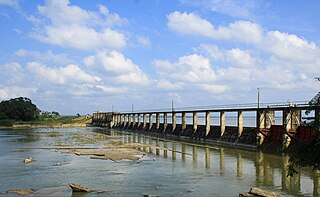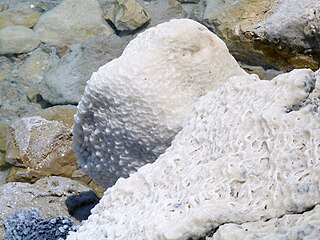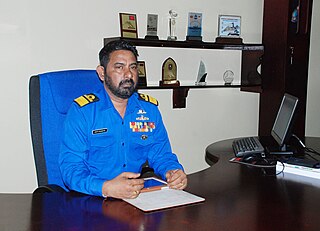| Chalai Lagoon | |
|---|---|
| Location | Mullaitivu District, Sri Lanka |
| Coordinates | 9°23′N80°40′E / 9.383°N 80.667°E Coordinates: 9°23′N80°40′E / 9.383°N 80.667°E |
| Type | Lagoon |
| Primary outflows | Indian Ocean |
| Surface area | 14.6 square kilometres (5.6 sq mi) |
| Surface elevation | Sea level |
| Settlements | Chalai Putumattalan Valayanmadam |
Chalai Lagoon is a lagoon in Mullaitivu District, north-east Sri Lanka. The town of Chalai is located on a sand bar between the lagoon and the Indian Ocean.

A lagoon is a shallow body of water separated from a larger body of water by barrier islands or reefs. Lagoons are commonly divided into coastal lagoons and atoll lagoons. They have also been identified as occurring on mixed-sand and gravel coastlines. There is an overlap between bodies of water classified as coastal lagoons and bodies of water classified as estuaries. Lagoons are common coastal features around many parts of the world.

Mullaitivu District is one of the 25 districts of Sri Lanka, the second level administrative division of the country. The district is administered by a District Secretariat headed by a District Secretary appointed by the central government of Sri Lanka. The capital of the district is the town of Mullaitivu.

Sri Lanka, officially the Democratic Socialist Republic of Sri Lanka, is an island country in South Asia, located in the Indian Ocean to the southwest of the Bay of Bengal and to the southeast of the Arabian Sea. The island is geographically separated from the Indian subcontinent by the Gulf of Mannar and the Palk Strait. The legislative capital, Sri Jayawardenepura Kotte, is a suburb of the commercial capital and largest city, Colombo.
The lagoon is fed by a number of small rivers. It is linked to the sea by a narrow channel near Chalai. The lagoon's water is brackish.

A river is a natural flowing watercourse, usually freshwater, flowing towards an ocean, sea, lake or another river. In some cases a river flows into the ground and becomes dry at the end of its course without reaching another body of water. Small rivers can be referred to using names such as stream, creek, brook, rivulet, and rill. There are no official definitions for the generic term river as applied to geographic features, although in some countries or communities a stream is defined by its size. Many names for small rivers are specific to geographic location; examples are "run" in some parts of the United States, "burn" in Scotland and northeast England, and "beck" in northern England. Sometimes a river is defined as being larger than a creek, but not always: the language is vague.

In physical geography, a channel is a type of landform consisting of the outline of a path of relatively shallow and narrow body of fluid, most commonly the confine of a river, river delta or strait. The word is cognate to canal, and sometimes takes this form, e.g. the Hood Canal.
The lagoon is surrounded by dense forest, scrubland and some rice paddies. The land is used for fishing and some salt production.

A forest is a large area dominated by trees. Hundreds of more precise definitions of forest are used throughout the world, incorporating factors such as tree density, tree height, land use, legal standing and ecological function. According to the widely used Food and Agriculture Organization definition, forests covered 4 billion hectares (9.9×109 acres) (15 million square miles) or approximately 30 percent of the world's land area in 2006.

Fishing is the activity of trying to catch fish. Fish are normally caught in the wild. Techniques for catching fish include hand gathering, spearing, netting, angling and trapping. “Fishing” may include catching aquatic animals other than fish, such as molluscs, cephalopods, crustaceans, and echinoderms. The term is not normally applied to catching farmed fish, or to aquatic mammals, such as whales where the term whaling is more appropriate. In addition to being caught to be eaten, fish are caught as recreational pastimes. Fishing tournaments are held, and caught fish are sometimes kept as preserved or living trophies. When bioblitzes occur, fish are typically caught, identified, and then released.

Salt is a mineral composed primarily of sodium chloride (NaCl), a chemical compound belonging to the larger class of salts; salt in its natural form as a crystalline mineral is known as rock salt or halite. Salt is present in vast quantities in seawater, where it is the main mineral constituent. The open ocean has about 35 grams (1.2 oz) of solids per liter of sea water, a salinity of 3.5%.
The lagoon has extensive sea grass beds and mangrove swamp. The lagoon attracts a wide variety of water birds including ducks, gulls, terns and other shorebirds.

A mangrove swamp is a distinct saline woodland or shrubland habitat formed by mangrove trees. They are characterized by depositional coastal environments, where fine sediments collect in areas protected from high-energy wave action. The saline conditions tolerated by various mangrove species range from brackish water, through pure seawater, to water concentrated by evaporation to over twice the salinity of ocean seawater.

The term water bird, waterbird or aquatic bird is used to refer to birds that live on or around water. Some definitions apply the term especially to birds in freshwater habitats, though others make no distinction from birds that inhabit marine environments. In addition, some water birds are more terrestrial or aquatic than others, and their adaptations will vary depending on their environment. These adaptations include webbed feet, bills and legs adapted to feed in water, and the ability to dive from the surface or the air to catch prey in water.
Shorebirds were a short-lived Punk Rock band from Olympia, WA formed in 2007 by Mattie Jo Canino, Chris Bauermeister and Keith Henderson. The band can be considered something of a supergroup due to the band featuring members of Jawbreaker, Latterman and RVIVR.










